Market
Art Basel’s Day-One Sales Show Demand for Fresh Work Is Undented, While Secondary Material Receives More Price Scrutiny
Economic jitters did not spell doom, but a market recalibration could be at hand.
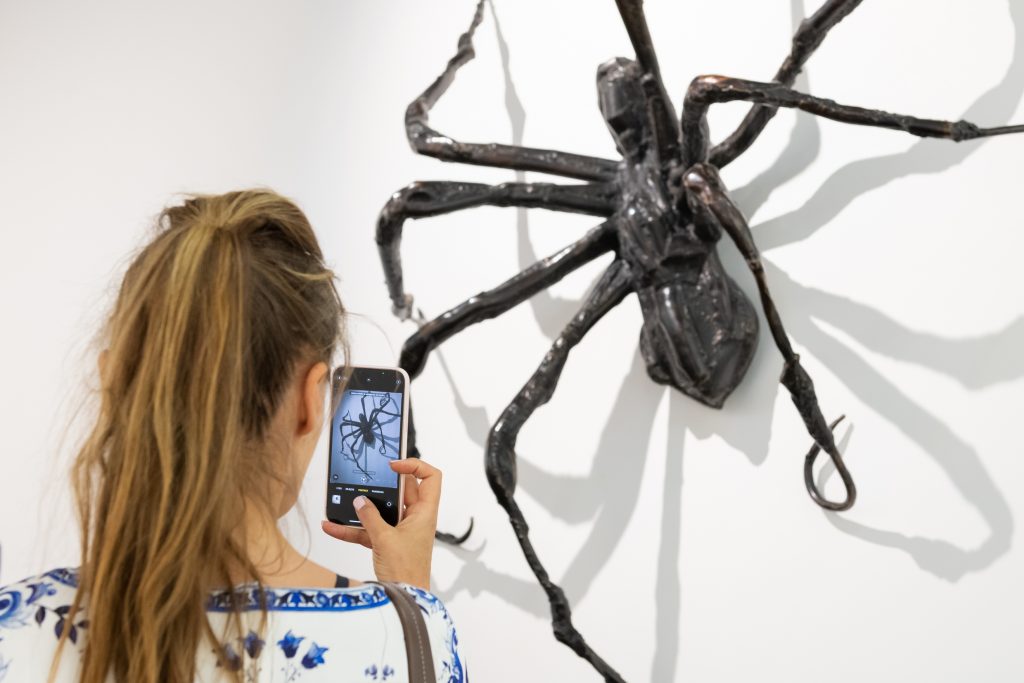
Economic jitters did not spell doom, but a market recalibration could be at hand.

Naomi Rea

As the sun beat down on the Messeplatz in Basel, Switzerland, the Monegasque art collector and mega-dealer David Nahmad was first to set foot in the main concourse of Art Basel, the world’s premiere art fair. But his confident swagger belied the big questions on the minds of many market stakeholders going into the day.
The world is in an uncertain moment, geopolitically and financially. There is war in Ukraine, we are at the beginning of election cycle in the U.S., and interest rates have finally risen after being held at artificially low levels for more than a decade. Inflation is up, and that means people who had been parking excess wealth in art and using it as collateral to borrow more are facing a new reality. What happens now that, as advisor Todd Levin recently put it, “the money spigot has been turned off”?
Some collectors opted to skip Basel entirely this year. And there’s a risk-off attitude among those who did show up, as some wonder whether now would be a better time to buy bonds than art.
U.S. collector Mihail Lari, who is returning to the fair for the first time since lockdown, noted that while gold seemed to be a prominent feature in many of the artworks on offer, some might be thinking that “maybe gold bars would be a safer bet during the continuing political and financial upheavals.”
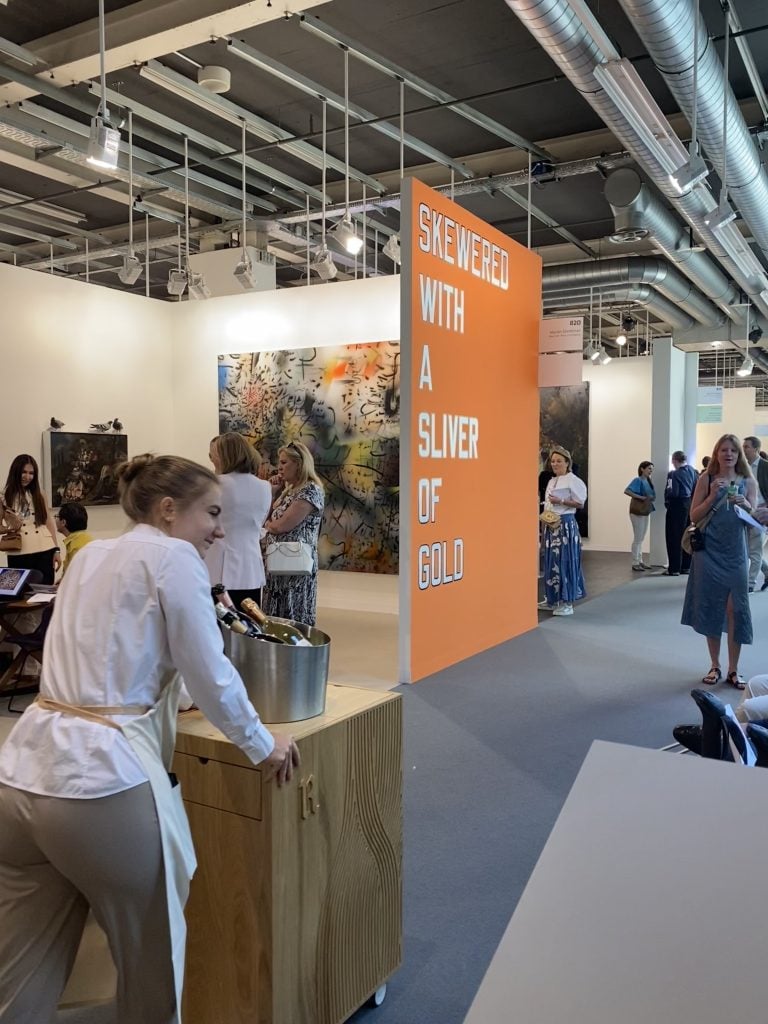
Art Basel 2023. Photo by Naomi Rea.
That sentiment dovetails with a strongly felt general sense that art prices, which had long been spinning out of control, were finally about to hit a ceiling. “I think that generally art took a massive inflation,” advisor Sibylle Rochat told Artnet News. “Any fairly nice painting by a mid-career artist [without massive institutional support] is now around $300,000, which is too expensive in my opinion. Young artists with a bio the size of a stamp are now $30,000 to $50,000. Before, emerging art was what was making the art world accessible. It’s not anymore, and the joy is gone.”
As a result, galleries were working harder than ever ahead of time to stage-manage the success of the fair. The preview PDFs were heavier than ever— Art Basel will have a big job in front of it ensuring that every gallery does indeed present every work they said they would bring—and there was vigorous pre-selling activity in the run-up to the fair.
Collector Jens Farschou noted that Gagosian’s preview clocked in at around 120 works and David Zwirner’s at around 200. “In my opinion, these activities around the fair have become a circus and have not much to do with the original concept of an art fair,” he said. “The beautiful thing about the art fair—especially Art Basel—is that the entire world gathers around the art.”
Perhaps as a reaction to the desire to see art in a less transactional tone—as well as in person, for many who are just now returning to live events since lockdown—there was a sense that gallerists took more care with their booth presentations at the fair this year. One advisor noted that the dealers might be catering toward “fewer advisors, more curators” due to the exit of the investors from the art-buying arena. Among the curators spotted roaming the booths were Cecilia Alemani, Carolyn Christov-Bakargiev, and Doryun Chong, Rhein Wolfs, Daniel Birnbaum, and Alexie Glass-Kantor.
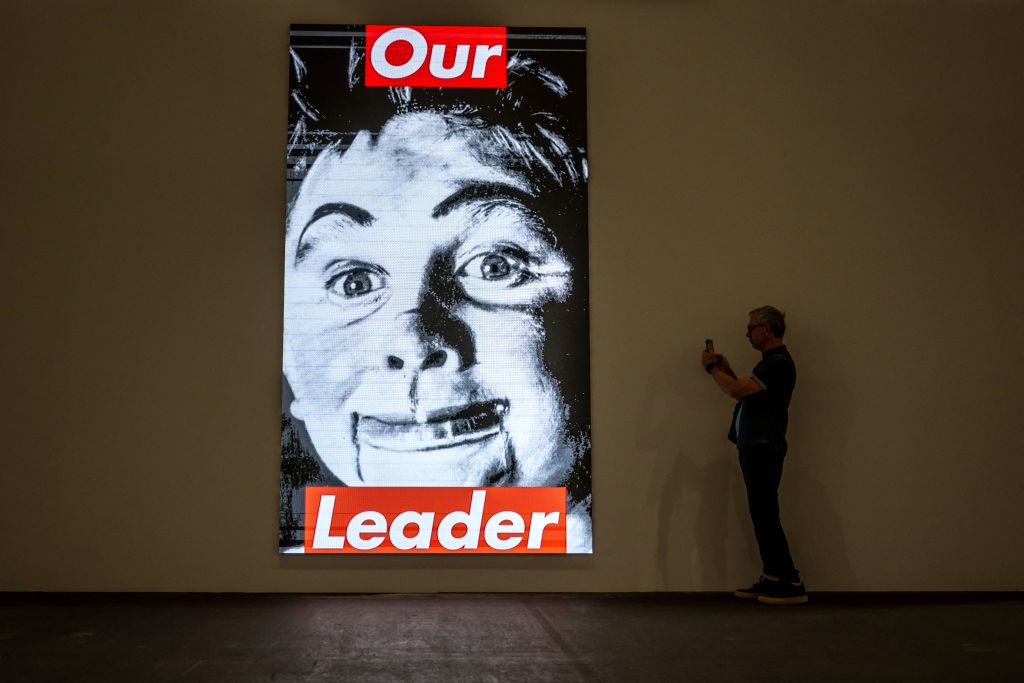
A visitor takes a picture next to “Untitled (Our Leader)” 1987/2020 by US conceptual artist Barbara Kruger, displayed at the Unlimited section of the Art Basel fair for Modern and contemporary art, in Basel, Switzerland on June 13, 2023. Photo by Fabrice Coffrini/AFP via Getty Images.
Last year, the blue-chip galleries were devoting ground-floor real estate to younger artists side by side with their established names on the fair’s first day, reflecting the ravenous market for emerging art, which was being leveraged to help support of the rest of their programming. This year, there was a return to form with classic blue-chip fare taking center stage. There was also a feeling that booths were better curated, even outside of the Features section devoted to historical solo presentations, and Kabinett, a new sector for curated offerings.
A highlight for Swiss collector Suzanne Syz was Sadie Coles HQ’s solo presentation of Laura Owens in the main section. “The fair was not as hectic, but that’s a good thing. The art market was too crazy,” Syz said. “I think it’s good that it comes down to a normal level. It was not healthy, especially for young artists who were getting burned.”
Syz was in discussions about a Philippe Parreno “speech bubble” work at Pilar Corrias, despite the fact that the pieces are not the easiest to own, as they require reinflation every three months. There was a fair amount of sculpture being placed with collectors, suggesting an intent to live with the art, rather than two-dimensional paintings that are more easily stored—and flipped.
“If there’s a recalibration, it’s that people are not buying art for ridiculous prices, but they are certainly buying art for the right prices,” Pace gallery president Marc Glimcher told Artnet News. Among the gallery’s first-day sales were a Calder mobile for $2.8 million, three editions of an Elmgreen & Dragset lifeguard sculpture for between $350,000 and $425,000, and, yes, several coveted pencil drawings by Yoshitomo Nara for an undisclosed price. A $14 million Joan Mitchell triptych on view, however, hadn’t found a buyer by day’s end.
The sale reports coming in at the end of day one attested to continued demand on the primary market for young artists, especially those whose auction results are on the upswing. David Kordansky sold a Lucy Bull painting for between $100,000 and $150,000, as well as a Chase Hall for an undisclosed price. Xavier Hufkens sold two paintings by Ulala Imai for between $90,000 and $125,000, ahead of an exhibition with the artist at their Brussels gallery slated for September.
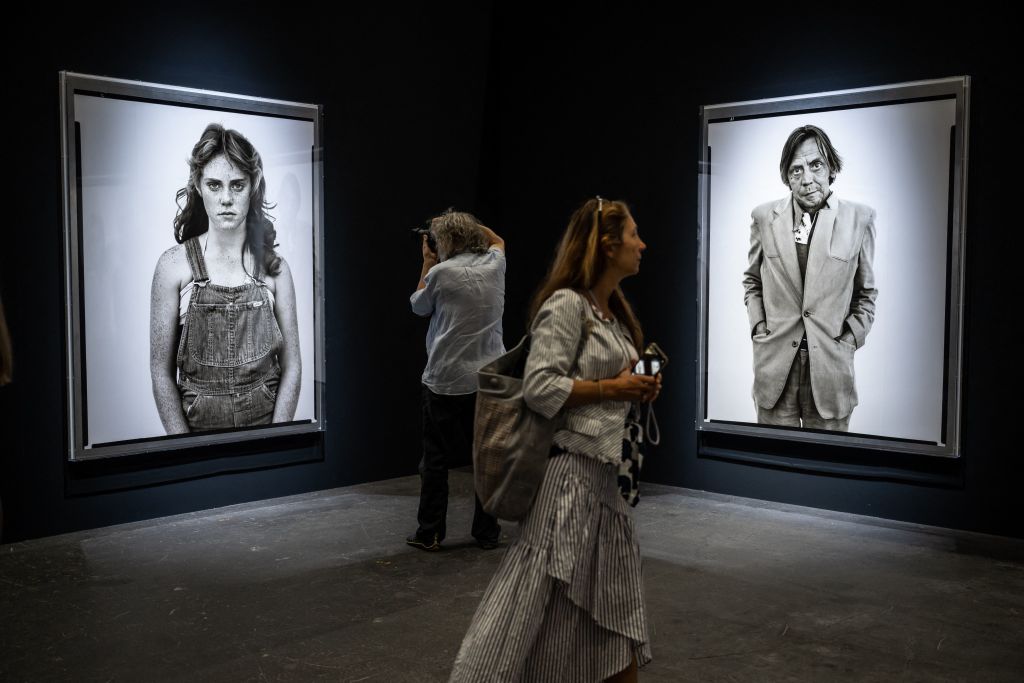
Visitors walk past pictures by US photographer Richard Avedon at “the Ten Exhibition Prints from In the American West, photographed 1979-1984” booth at the Art Basel fair for Modern and contemporary art, in Basel, Switzerland on June 13, 2023. Photo by Fabrice Coffrini/AFP via Getty Images.
There were strong results for blue-chip contemporary art as well. Hufkens also sold a glass sculpture in two parts by Roni Horn for approximately $2.5 million; Lisson gallery’s sales included a Sean Scully painting for $875,000; and Hauser and Wirth sold a Rashid Johnson “Seascape” for $975,000.
Many more sales were reported from galleries across the market spectrum by day’s end. At Art Unlimited, the fair’s section for works too big to be shown in a booth, David Zwirner and Sprüth Magers jointly sold a Barbara Kruger for $1.3 million and a Gerhard Richter for $2.5 million. White Cube sold a new sculpture by Doris Salcedo, who is the subject of a much-talked-about exhibition on view at the Fondation Beyeler, to a major institution for $1.125 million, and almost the entire edition of new Georg Baselitz sculptures for €1.7 million each.
Goodman Gallery placed Shirin Neshat’s Land of Dreams (2019) with a South Asian institution for $275,000, and the Louisiana Musuem of Modern Art acquired Zineb Sedira’s DREAMS HAVE NO TITLES (Lightbox) (2023) for €80,000. Lehmann Maupin sold a Tom Friedman sculpture for $300,000 to a U.S. collector. Stephen Friedman parted with a Luiz Zerbini painting for $285,000. Pippy Houldsworth, who had a stunning solo presentation of Jacqueline de Jong, sold one painting, Pendant La Chute, for €160,000. And in the Statements section for younger positions, Soft Opening sold well from its solo presentation of Sin Wai Kin: two editions and corresponding “facial wipe” works for $22,000 and $29,000, and one additional “facial wipe” work for $7,000.
While the reported first-day results indicate no demand ceiling on the primary market, the secondary market does seem to have been more impacted by the uncertainty in the auction market, with the recalibration being seen in slower-to-move material and increased opacity on pricing.
Some buyers said it was indeed easier to acquire works that would have been inaccessible to them 24 months ago, particularly on the emerging side of the spectrum, reflecting, as advisor Wendy Goldsmith put it, a “last-chance saloon” attitude towards certain lesser-quality works by hot names. No one wants to be left holding a B+ painting when it all goes south, after all.
David Zwirner took the surprise decision not to disclose prices on secondary-market sales made this year, and reported to press that he would no longer do so going forward. That makes it hard to gauge whether such sales by his gallery—of works by Joan Mitchell, Marlene Dumas, Gerhard Richter, or Agnes Martin—reflected a more rational pricing environment or not.
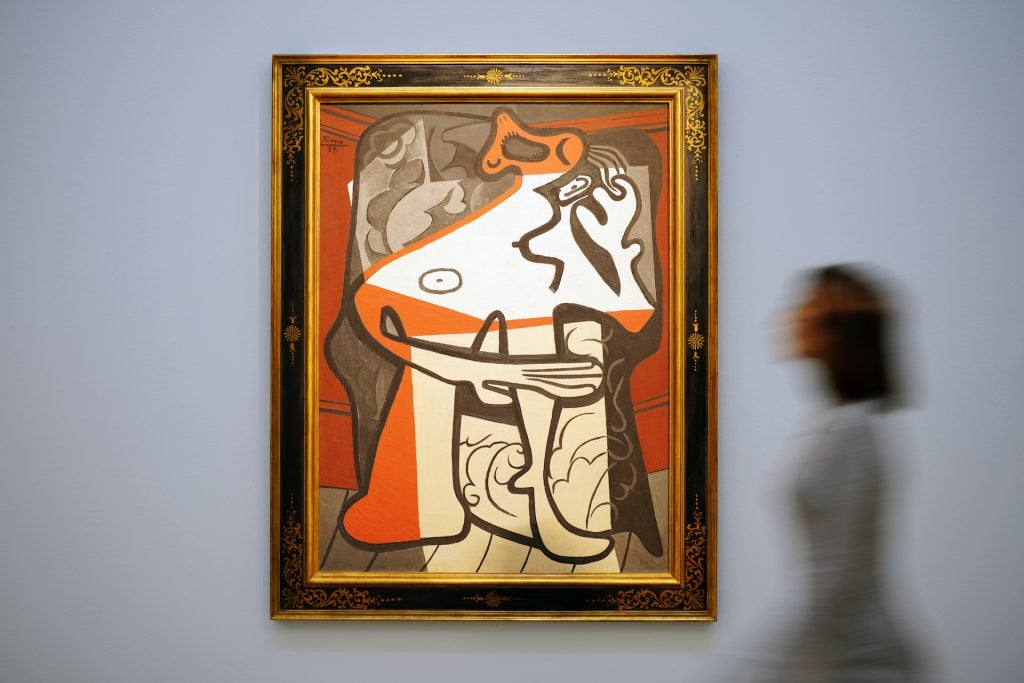
Pablo Picasso’s Femme dans un fauteuil (1927), estimated at Sotheby’s in 2022 $15-20 million, it sold for $9 million. Photo by Michael Bowles/Getty Images for Sotheby’s.
Still, there is scarcity at the top. There is a finite supply of works by the most expensive artists, who have established value points. Robert Landau, of Landau Fine Art, a renowned dealer of Impressionist and Modern art, was therefore confident in the $25 million asking price for a beguiling 1927 Picasso portrait of Marie-Thérèse Walter. Laundau bought the painting, which was once in the collection of ex-Whitney president David Solinger, at auction in November for $9.9 million, a steal compared to its estimate of between $15 million and $20 million.
“You cannot just look at the auction price. You have to look at the painting,” he said. “You cannot overpay for a good picture. You can overpay for a bad picture, and you’ll never get your money back. But if you overpay for a good picture, time will correct your mistake.”
Landau acknowledged that there has been a market adjustment, estimating prices are down by around 25 percent on both the primary and secondary markets—”when it rains, it rains everywhere,” he said—and he pointed to a clear culprit: art dealers following the lead of the auctions and inflating the prices of living artists to “crazy” levels. “It’s not healthy, and I think they chased away confidence in the market,” he said. Landau does not share sales information but said he was certain the painting would find a good home.
No word, either, from Acquavella Galleries, which brought an exquisite orange Rothko painting formerly in the collection of Paul Mellon and reportedly consigned by mega-collector Steve Wynn with an asking price of $60 million (it last sold publicly in 2014 for $36.6 million).
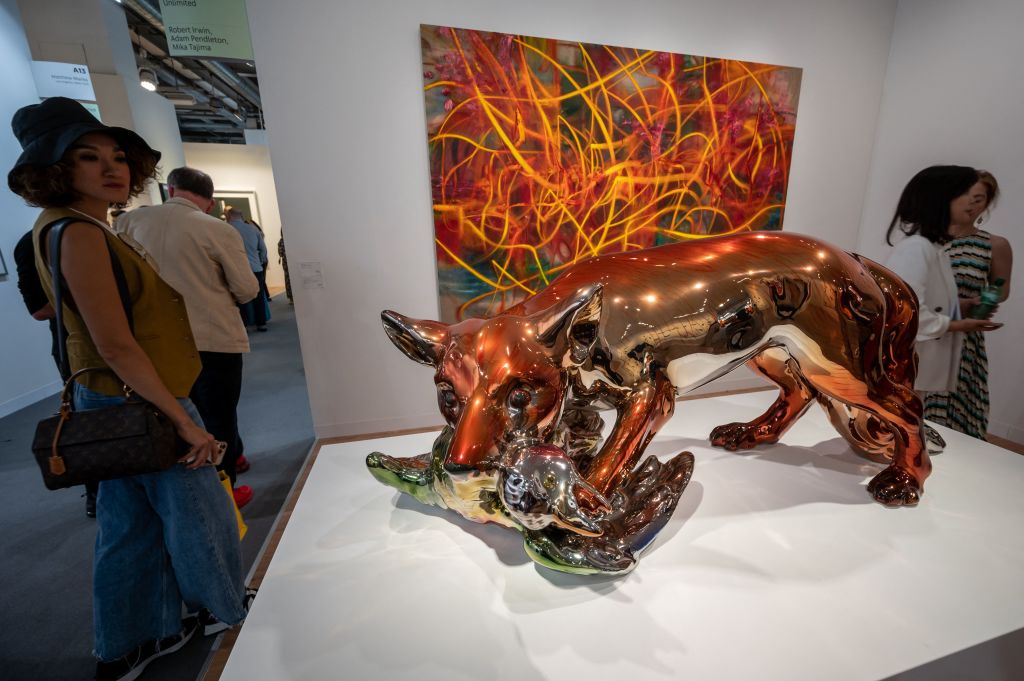
Fox with Bird (2016-2023) by US artist Jeff Koons, displayed at the gallery Pace during the Art Basel fair for modern and contemporary art, in Basel, Switzerland. Photo by Fabrice Coffrini/AFP via Getty Images.
A lot of quality expensive material did move on the first day, however. Hauser and Wirth sold a wall-mounted Louise Bourgeois spider, which was priced at $22.5 million, a 36 percent markup on the price for which it was acquired by its consignor last April at Sotheby’s Hong Kong. “It’s Basel at its best. It’s the center of gravity,” Iwan Wirth said. The gallery also found a home for a rare Bourgeois “Personages” sculpture for $7.5 million, and a $9.5 million Philip Guston painting.
By day’s end, Gagosian had sold more than 40 works, including a Cecily Brown painting Artnet News understands was priced at $6 million (Gagosian does not disclose prices).
Larry Gagosian said it was “too soon to tell” if a market recalibration is truly under way. Despite appearances at the auctions, he said: “I think things are picking up; the second half of the year will be very strong. We’re having a great fair, so I’m very encouraged.”
All told, while top-end prices may have become more rational, and deals were being cut at a more considered pace, gallerists said they were generally doing better, in terms of both sales volume and average price, compared to last year. So, what’s the big-picture takeaway for Art Basel 2023 so far? Yes, a market recalibration is likely underway. But, perhaps moving the focus away from record-setting prices and back onto the artistic achievements behind the headlines isn’t such a bad thing.
More Trending Stories:
Is Time Travel Real? Here Are 6 Tantalizing Pieces of Evidence From Art History